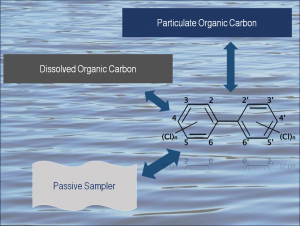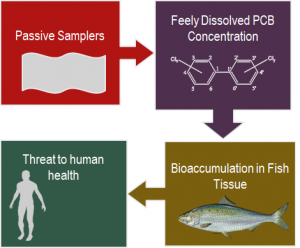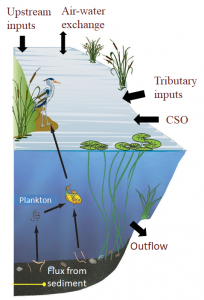Our group performs research in environmental engineering and science with a focus on the fate, effects, and remediation of toxic hydrophobic organic contaminants (HOCs) in the environment like polychlorinated biphenyls (PCBs), polyaromatic hydrocarbons (PAHs), pesticides, dioxins, and mercury. We explore the fundamental process mechanisms that control organic contaminant fate in soils, sediments, and aquatic environments by using multidisciplinary tools to investigate exposure and bioavailability of organic and metal contaminants to organisms. The new understanding is used to develop novel remediation technologies and site-specific remediation goals. Our projects fall under broadly the following three areas of Environmental Engineering:
- Analytical methods for the assessment of pollutant bioavailability,
- Assessment of pollutant fate and bioavailability,
- Development, demonstration, and transition of novel remediation technologies for polluted sediment
ANALYTICAL TOOLS: Passive Sampling
One of the major analytical tools that our group uses in quantifying the existing concentrations of the above mentioned HOCs in the environment is Passive Sampling. In passive sampling, we make use of the hydrophobic nature of the above mentioned HOCs and their preference for sorbing into the matrix of a sorbent polymer like polyethylene (PE) than staying dissolved in water.

Chemical monitoring of such organic compounds in water or sediment using passive sampling methods involves exposing the sorbent polymer in the medium of interest for a substantial amount of time over days, weeks or months. During this period of deployment, the compounds accumulate on the polymer until they reach an equilibrium concentration. The equilibrium sampling concentration and the time required to reach it, is a function of the hydrophobicity of the compound, the properties of the sorbent polymer and the concentration in the ambient medium.

The method of ‘passive’ sampling derives its name from the dominant principle of ambient convection and diffusion that leads to the transport of these compounds into the matrix of the sorbent polymer. This transport is often technically termed as partitioning. The rate of partition can be quantitatively estimated by using some pre-defined measurable partitioning coefficients and is a characteristic function of the contaminant-polymer pair.
The rate of partitioning of a contaminant into the polymer provides an estimate of the freely dissolved concentration that is a useful metric of the contaminant’s bioavailablity to the aquatic organisms or calculate the pollutant gradients across a single or pair of media. These contaminants exist in very low concentrations in the order of ng/L to pg/L in the environment. In contrast, the high level of concentration accumulated in a small sheet of polymer lets us avoid the problem of very low detection limits of the instruments used for detection. It also avoids the need for collecting and extracting large volumes of water to meet instrument detection limits, as done in most active sampling methods.
ASSESSMENT: Pollutant Fate and Bioavailability

Our group focuses on modelling the poorly defined matrices of fate and transport, bioavailabity and exposure of these hazardous organic compounds in the environment. Solving for this based on the kinetic and thermodynamic properties of the compounds often boils down to a mass transport model.The dissolved concentration of PCBs in water, for example, is contributed by dissolution from bed sediments, inputs from tributaries and outfalls and air-water exchange. The dissolved concentration controls exposure to aquatic organisms like fish and humans from water through food chain. The estimation of these concentrations from passive sampling of overlying and porewater or actively sampled bulk sediment or fish and mussels are carried out by lab analysis following EPA methods and high efficiency gas chromatography instruments.

The results are used for fate and transport models to estimate the quantity and direction of movement and chemical alterations, if any, of contaminants as they move through air, soil or water. Linking the fate/transport model to bioaccumulation models help predicting effectiveness of more targeted remediation strategies on pollutant concentrations in fish, link these causes of impairment to risk to human health and to utilize monetary resources more efficiently.
REMEDIATION: Development, demonstration and transition of novel technologies
In addition to laboratory analysis of impaired sediments and water bodies, our group also takes interest in development, pilot-scale and full-scale demonstration and transition of novel technologies for remediating these sites in collaboration with Sediment Solutions (Startup company established in 2009 specializing in in-situ sediment remediation:http://www.sedimite.com/) and RemBac (Startup company established in 2017 specializing in sediment bioremediation. www.rembac.com ).